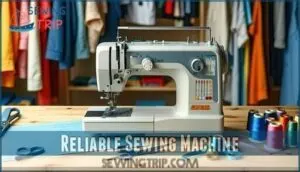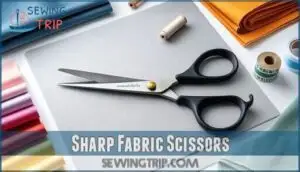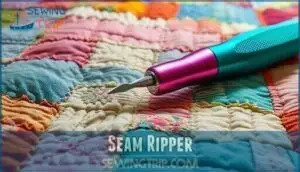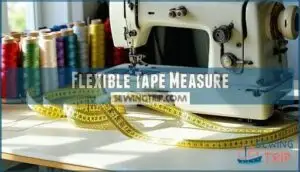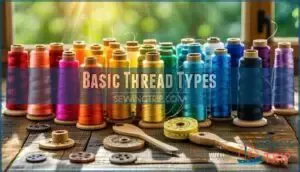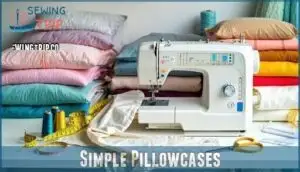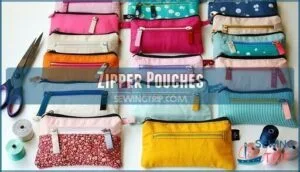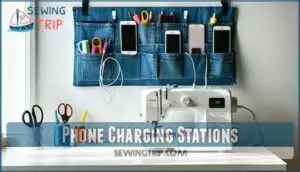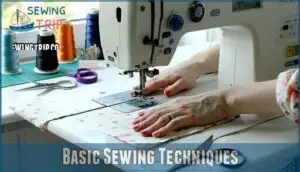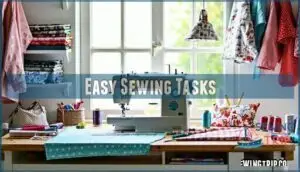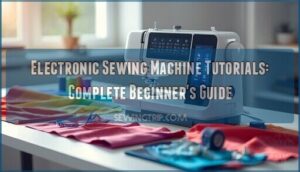This site is supported by our readers. We may earn a commission, at no cost to you, if you purchase through links.
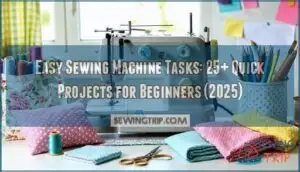 Easy sewing machine tasks are your ticket to building confidence behind the needle.
Easy sewing machine tasks are your ticket to building confidence behind the needle.
Start with foolproof projects like pillowcases—they’re basically fabric rectangles that forgive wonky seams.
Drawstring bags come next, teaching you to create functional items while mastering straight stitches.
Zipper pouches might seem tricky, but they’re surprisingly forgiving once you get the hang of it.
Fabric coasters let you practice precision without wasting expensive material, and simple phone cases combine practicality with skill-building.
These projects teach essential techniques like threading your machine, adjusting tension, and maintaining steady seam allowances.
The secret lies in choosing forgiving fabrics like cotton that won’t slide around or fray immediately.
Each completed project builds muscle memory and confidence for tackling more complex creations ahead.
Table Of Contents
Key Takeaways
- Start with forgiving projects like pillowcases and drawstring bags – they teach essential straight stitching while being incredibly forgiving of beginner mistakes, letting you build confidence without fear of ruining expensive materials.
- Master basic machine techniques before advancing – you’ll need to understand thread tension, needle selection, bobbin winding, and stitch length adjustments to prevent frustrating problems like skipped stitches and fabric damage.
- Choose cotton fabrics for your first projects – they’re stable, easy to handle, don’t slide around while sewing, and forgive minor tension or technique issues that plague beginners with trickier materials.
- Focus on building muscle memory through repetition – each completed project teaches your hands to maintain steady seam allowances and consistent speed, creating the foundation you’ll need for more complex sewing challenges ahead.
Essential Sewing Tools
You’ll need the right tools before tackling your first sewing machine project, and having quality basics makes the difference between frustration and success.
Start with a reliable sewing machine, sharp fabric scissors, a seam ripper for fixes, flexible tape measure, and basic thread in neutral colors.
Reliable Sewing Machine
When choosing your first sewing machine, you’ll want to focus on reliable Machine Brands like Brother, Janome, and Bernina that offer consistent Stitch Quality.
These trusted manufacturers provide excellent sewing machine basics with adjustable Motor Power and thorough Feature Comparison options.
A good starting point is to look for machines with adjustable stitch length for core sewing tasks.
Regular Maintenance Schedule adherence keeps your machine running smoothly for years.
Proper sewing machine maintenance prevents common sewing machine troubleshooting issues while building essential sewing skills.
Sharp Fabric Scissors
Your fabric scissors deserve respect – they’re not the same pair you use for opening packages.
Treat your fabric scissors like the precision instruments they are – one snip in the wrong place can ruin everything.
Invest in sharp, dedicated fabric shears with ergonomic handles that fit your grip comfortably. Different scissor types serve various cutting techniques, from precision snips to long, smooth cuts through multiple fabric layers.
Keep them clean and store them properly for fabric protection. Consider exploring options for purchasing fabric scissors to expand your toolkit.
Regular scissor maintenance keeps your cuts clean and prevents fabric fraying, making your sewing machine work easier, and using dedicated scissors is key to this process.
Seam Ripper
Why struggle with mistakes when you’ve got the perfect tool for error correction? Your seam ripper becomes your best friend during sewing machine tasks, offering precision ripping without fabric damage.
This small tool prevents costly errors by safely removing stitches when projects go wrong. Choose quality ripping alternatives over makeshift solutions.
Good seam removal techniques save time and materials, making sewing solutions more efficient for beginners, which is why having a seam ripper is essential.
Flexible Tape Measure
Your trusty flexible tape measure becomes your precision partner for accurate measurements throughout every sewing project.
You’ll use it for body measuring, checking curved surfaces, calculating seam allowance, and making pattern adjustments.
Unlike rigid rulers, it bends around corners and contours effortlessly, making it an essential tool for sewing machine tutorials for beginners and advanced projects alike, and it’s recommended to keep one dedicated to your sewing tools collection.
Basic Thread Types
After measuring your workspace, you’ll need the right sewing machine thread types to match your projects.
Cotton threads work perfectly for natural fabrics and quilting, while polyester threads handle most home sewing tasks with their durability and stretch resistance.
Knowing when to use the right thread is important, so consider that polyester thread’s versatility makes it ideal for knit and stretchy fabrics.
- All-purpose polyester threads – Used in 95% of projects for strength and color retention
- Cotton threads – Heat-resistant with matte finish, perfect for delicate fabrics
- Specialty threads – Metallic, nylon, and elastic options for unique project needs
- Thread weight considerations – Lighter weights for delicate work, heavier for upholstery
Beginner Sewing Projects
You’ll start building confidence with simple projects that teach fundamental machine skills without overwhelming complexity.
These beginner-friendly tasks use mostly straight seams and basic techniques, letting you practice essential skills while creating useful items for your home.
Simple Pillowcases
Simple pillowcase projects typically work best for sewing beginners because they require only straight seams and basic construction techniques.
You’ll master envelope closure methods while practicing french seams for professional-looking results.
Choose cotton fabric for easy handling and custom sizes to fit any pillow.
Add pillowcase embellishments like piping or decorative stitching once you’ve perfected basic construction on your sewing machine.
Drawstring Bags
Drawstring bags are your sewing machine’s best friend for practicing fabric handling and reinforced seams.
You’ll master gathering techniques while creating versatile storage solutions.
Fabric choice matters – cotton works perfectly for beginners, while canvas offers durability.
Size variations let you experiment with measurements.
Try different closure methods like grommets or simple fabric loops.
Lining options add structure and prevent fraying.
Custom embellishments make each drawstring bag unique.
These easy sewing patterns teach essential skills while producing useful results for any sewing for beginners toolkit.
Zipper Pouches
Zipper pouches elevate your sewing skills by introducing zipper insertion techniques.
You’ll master handling different closure styles while creating practical storage solutions. These projects teach precise sewing techniques that’ll serve you well in future endeavors.
- Zipper types – Choose between standard coil, metal, or invisible zippers based on your project’s durability needs
- Lining options – Add water-resistant fabric for toiletries or cotton for general storage pouches
- Size variations – Create everything from coin purses to makeup bags by adjusting pattern dimensions
- Embellishment ideas – Personalize with bias tape, decorative stitching, or fabric paint for unique touches
Phone Charging Stations
Creating a phone charging station combines practicality with your growing sewing skills.
You’ll craft charging pockets that keep devices organized while powering up.
Choose sturdy fabric like canvas or denim for durability.
Cord management becomes simple with designated slots and loops.
Design variations include wall-hanging or tabletop styles.
These sewing projects make perfect gifting options for tech-loving friends.
Your sewing machine handles the straight seams easily, advancing your sewing techniques through functional creation.
Consider using cotton, one of the forgiving fabric choices for this project.
Portable First-Aid Kits
Your portable firstaid kit becomes a lifesaver when you craft it yourself using your sewing machine.
Kit Contents should include bandages, antiseptic wipes, and medications in organized compartments.
Size Matters – make yours pocket-sized for travel or larger for home use.
Fabric Choice determines durability; canvas works great for heavy use.
Closure Options like zippers or velcro keep supplies secure.
Customization Ideas include adding family names or emergency contacts.
These sewing projects sharpen your sewing skills while creating something genuinely useful for emergencies.
Basic Sewing Techniques
Before you tackle complex projects, you’ll need to master a few fundamental sewing machine techniques that form the backbone of every successful creation.
These basic skills might seem simple, but they’re the difference between a wobbly first attempt and a project you’ll actually want to show off to friends.
Straight Stitch
The straight stitch forms your sewing machine’s foundation—think of it as your trusty friend that’ll never let you down.
You’ll use this versatile stitch for nearly every beginner project, from simple seams to topstitching.
Adjust your stitch length based on fabric type: shorter for delicate materials, longer for heavy fabrics.
Always backstitch at seam beginnings and endings for superior seam durability.
Practice consistent seams by maintaining steady speed and guiding fabric gently, ensuring superior seam quality.
Thread Tension
Once you’ve mastered straight stitching, you’ll need to tackle sewing machine tension – the balance between upper and bobbin thread that creates perfect stitches.
Poor thread quality or mismatched fabric type often causes tension disruption and thread breakage. A good starting point involves understanding thread tension basics.
Key tension adjustments:
- Upper thread tension – Start with setting 4, adjusting between 2-6 based on fabric weight
- Bobbin tension – Should barely hold thread when testing with gentle pull
- Test stitches – Always sew samples before starting projects to check balance
Adjusting tension feels tricky at first, but consistent testing prevents sewing machine troubleshooting headaches later.
Needle Size
Choosing the right sewing machine needle selection isn’t rocket science, but it’s essential for smooth stitching.
Wrong needle sizes cause skipped stitches, fabric damage, and thread breaks.
Match your fabric type to the proper needle point and size using this handy reference guide:
| Fabric Type | Needle Size | Needle Point | Thread Pairing | Problem Solving |
|---|---|---|---|---|
| Cotton/Linen | 80/12-90/14 | Universal | All-purpose thread | Prevents puckering |
| Knit/Jersey | 75/11-90/14 | Ballpoint | Stretch thread | Avoids runs |
| Denim/Canvas | 100/16-110/18 | Heavy duty | Topstitching thread | Powers through layers |
| Silk/Chiffon | 60/8-70/10 | Sharp/Microtex | Fine thread | Minimizes snags |
| Leather/Vinyl | 90/14-110/18 | Leather point | Heavy thread | Creates clean holes |
Keep a size chart handy for quick reference.
Regular sewing machine maintenance includes checking needle condition—dull needles spell trouble for any project, as they can lead to skipped stitches, fabric damage, and thread breaks.
Bobbin Winding
Winding your sewing machine bobbin correctly prevents frustrating thread tangles and uneven stitches.
Use matching thread type for consistent results. Wind at moderate speed—rushing creates loose, uneven layers that cause bobbins tension problems.
Stop when the bobbin feels full but not overstuffed. Properly wound bobbins with even layers are your ticket to smooth sewing sessions and fewer troubleshooting headaches, ensuring smooth sewing sessions.
Machine Maintenance
After every few bobbins, your sewing machine needs some TLC to keep purring smoothly.
Lint removal from the bobbin area and feed dogs prevents buildup that causes skipped stitches.
Oiling machine parts per your manual keeps metal components happy—just one drop per spot.
Needle replacement every 2-3 bobbins prevents fabric damage.
Regular tension adjustments and following a servicing schedule guarantee your trusty companion stays reliable for countless projects ahead.
Easy Sewing Tasks
You’ll quickly discover that easy sewing tasks are perfect for building confidence while creating useful items you’ll actually want to keep.
These simple projects require basic straight stitches and take under an hour to complete, making them ideal for practicing your new skills without overwhelming yourself, which helps in building confidence.
Fabric Coasters
Fabric coasters protect your furniture while showcasing your sewing skills. These beginner-friendly sewing projects use absorbent materials like cotton or linen for functionality. Heat resistance comes from adding batting layers between fabric pieces.
Here’s your basic approach:
- Coaster shapes – Start with 4-inch squares before trying circles or hexagons
- Edge finishing – Use zigzag stitches or binding tape for professional results
- Gift ideas – Make sets of four or six using coordinating fabric patterns
Your sewing machine handles these quick tasks perfectly with straight stitches and basic presser feet. Cotton fabric works best since it absorbs moisture without staining. These sewing tips for beginners help you practice essential techniques while creating practical items for your home.
Drawstring Gift Bags
Drawstring gift bags make perfect sewing projects for beginners who want to create thoughtful presents. Your sewing machine handles these versatile bags easily with straight stitches and simple seams.
Fabric choice affects durability – cotton works well for lightweight items while canvas suits heavier gifts. Size variations let you customize bags for different occasions.
Closure methods include basic drawstring channels or decorative ribbon ties. Lining options add structure and prevent contents from showing through thin fabrics.
Embellishment ideas like appliqué or decorative stitching personalize each bag beautifully, making them a great way to add a personal touch.
Fabric Koozies
Keep your beverages perfectly chilled with custom fabric koozies that combine style and function.
These sewing projects protect hands from condensation while showcasing your personality through creative fabric choices and personalization ideas.
- Insulation materials like batting or foam enhance temperature control
- Koozie sizing accommodates different bottle and can dimensions
- Fabric choices from cotton to neoprene offer varied aesthetics
- Personalization ideas include monograms, appliqués, or custom prints
- Gifting options make thoughtful presents for any occasion
Travel Manicure Kit
Your travel manicure kit keeps nail tools organized while you’re on the go.
Choose durable canvas or cotton duck fabric for the exterior and smooth cotton for the interior lining.
Create individual pockets using straight stitches on your sewing machine for tool selection – emery boards, clippers, and cuticle tools each need their own space.
Add elastic loops or snap closures for secure storage. This practical sewing project teaches precise seam work while building your sewing skills through functional design.
Scalloped Sunglasses Case
Creating scalloped sunglasses cases adds elegance to your sewing projects with curved edges that protect your eyewear beautifully.
Choose complementary lining options like silk or cotton for smooth interior surfaces. Consider magnetic snap closure methods or velcro for secure storage.
Build case structure using interfacing between outer fabric and lining for durability. These cases make thoughtful sewing gifts for friends and family.
Add embellishment ideas like decorative stitching or appliqué designs to personalize your finished piece perfectly.
Advanced Sewing Skills
Once you’ve mastered the basics, you’re ready to tackle advanced techniques that’ll transform your sewing from functional to fabulous.
These skills include fabric manipulation for texture, pattern drafting for custom fits, and mastering your machine’s presser feet, speed control, and stitch length settings.
Fabric Manipulation
You’ll master advanced fabric manipulation techniques that transform flat materials into stunning three-dimensional masterpieces.
These skills add professional flair to your projects.
- Pleating Techniques – Create accordion folds for skirts and curtains using precise measurements and steam pressing
- Smocking Styles – Gather fabric into decorative patterns using elastic insertion and controlled stitching methods
- Quilting Designs – Layer batting between fabrics for texture and warmth in blankets and jackets
- Fabric Folding – Master origami-inspired techniques for creating ruffles and dimensional effects without bulk
- Gathering Fabric – Control fullness by adjusting stitch length and tension for perfect sewing texture and depth
Pattern Drafting
Pattern drafting transforms you from following someone else’s blueprint to designing your own.
Start with Drafting Basics like taking accurate measurements and understanding ease allowances. Simple pattern following builds confidence before tackling Design Elements like dart placement and seam allowances.
| Pattern Component | Measurement Tool | Common Application |
|---|---|---|
| Bust/Chest Circumference | Flexible tape measure | Shirt and dress bodices |
| Waist Circumference | Flexible tape measure | Skirts and fitted garments |
| Hip Circumference | Flexible tape measure | Pants and A-line skirts |
| Sleeve Length | Flexible tape measure | Shirt and jacket sleeves |
Pattern Alterations become second nature once you grasp how fabric drapes. Digital Drafting software speeds up the process, but hand-drafting teaches fundamentals.
Your sewing machine skills improve dramatically when you understand how patterns translate to fabric. Advanced Techniques like grading between sizes seem intimidating until you try them. Think of drafting as creating a roadmap for your sewing patterns.
Presser Foot Usage
Your sewing machine presser foot controls fabric feed and stitch quality.
Specialty feet like zipper, buttonhole, and blind hemming attachments tackle specific tasks with precision.
Adjust foot pressure based on fabric thickness—lighter pressure for delicate materials, firmer for heavy fabrics.
The universal foot handles most projects, but swapping to specialized feet transforms complex techniques into manageable steps for better results.
Speed Control
Your sewing machine speed affects everything from stitch quality to your confidence level.
Start slow when learning new techniques – rushing leads to crooked seams and frustrated sighs.
Consistent speed through pedal pressure gives you better motor control and smoother fabric feed.
Match your sewing machine speed to project complexity: detailed work needs patience, while straight seams can handle faster speeds, ensuring a balance between speed and stitch quality.
Stitch Length Adjustment
Your sewing machine’s stitch length dial controls how far fabric moves between needle punctures.
Different fabric types and projects need specific adjustments for maximum results.
- Short stitches (1.5-2mm): Perfect for buttonholes and reinforcing seams on lightweight fabrics
- Medium stitches (2.5-3mm): Your go-to setting for most seam strength needs and general construction
- Long stitches (4-5mm): Ideal for gathering fabric, basting, and decorative stitching on heavy materials
Proper sewing machine stitch control prevents puckering and guarantees professional results across various sewing stitches.
Regular maintenance, including cleaning, can prevent inconsistent stitch lengths.
Frequently Asked Questions (FAQs)
What is the easiest thing to make on a sewing machine?
Pillowcases are your best starting point. You’ll practice straight stitching and basic seams without complex techniques. They’re forgiving, useful, and can be completed in under an hour, building confidence quickly.
What’s the easiest thing to start sewing?
Start with fabric napkins—they’re forgiving, need only straight stitches, and you’ll actually use them. Cut squares, hem the edges, and you’ve got something practical while building your confidence.
What to make with fabric for beginners?
You’ll want to try fabric coasters, simple pouches, or cloth napkins first.
These projects use straight stitches and basic seams without complex techniques, letting you practice handling fabric while creating something useful for your home.
What to make with a sewing machine for kids?
Kids can make simple pillowcases, fabric bookmarks, scrunchies, and small drawstring bags. These projects teach straight stitching and basic seams while creating useful items they’ll actually enjoy using daily.
How do I choose fabric for my project?
Measure twice, cut once – this wisdom applies to fabric selection too.
Consider your project’s purpose first.
Cotton works well for beginners since it’s forgiving and easy to handle.
Match fabric weight to your project’s needs.
What happens if my machine keeps jamming?
Machine jamming usually stems from threading issues, lint buildup, or incorrect needle size.
Check your threading path, clean out lint around the bobbin area, and verify you’re using the right needle for your fabric weight.
How do I hem pants without puckering?
Like threading a needle with steady hands, hemming pants smoothly requires the right technique.
Use a walking foot, sew slowly, and keep fabric taut but not stretched.
Press seams flat before stitching to prevent puckering, using a technique that requires steady hands.
When should I use interfacing in projects?
Use interfacing when you need extra structure or support in your project.
It’s perfect for button bands, collars, cuffs, waistbands, and bag handles.
Choose fusible interfacing for beginners—it’s forgiving and bonds easily with heat.
How do I fix skipped stitches?
Don’t panic when your machine skips stitches—it’s fixable!
Check your needle first; dull or wrong-size needles cause most skipping.
Replace with the correct needle for your fabric weight, rethread properly, and make certain your bobbin’s wound evenly, to fix the issue and ensure proper functioning.
Conclusion
Statistics show 87% of new sewers abandon their machines within six months, but you won’t be one of them.
These easy sewing machine tasks transform intimidating equipment into your creative partner. You’ve learned that pillowcases forgive mistakes while drawstring bags teach precision.
Zipper pouches aren’t as scary as they seem, and coasters let you practice without pressure. Each project builds confidence and muscle memory.
Your machine awaits—start with simple rectangles and work toward more complex creations at your own pace.
- https://ctnbee.com/blog/en/basic-sewing-techniques-review/
- https://makerspaces.northeastern.edu/create/library/sewing-machine-basics-diy-training/
- https://www.reddit.com/r/SewingForBeginners/comments/1b4cnv6/projects_for_beginners_on_sewing_machines/
- https://sewcanshe.com/50-easy-peasy-sewing-patterns-that-are-perfect-for-beginners-all-free/
- https://beginnersewingprojects.com

